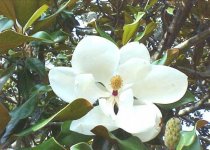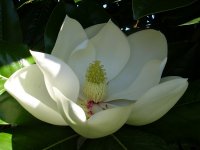Large-flowered magnolia
Magnolia grandiflora L.
Botanical characteristics. The family is magnoliaceous. Evergreen tree up to 30 m high, covered with brown bark. The dense crown has a pyramidal shape. The leaves are large, shiny, dark green, leathery, on a short petiole, oval in shape. The flowers are white solitary, very large, with a pleasant aroma, so strong that in a small enclosed space it can cause a headache. Blossoms in May-September. Fruits - leaflets collected in erect cones, ripen in October, November.
Spread. In our country it grows in the Crimea and on the Black Sea coast of the Caucasus.
Used parts of the plant.
Leaves.
The hypotensive effect of magnolia preparations is probably due to magnolin and magnolamine alkaloids. In chemical structure, both alkaloids are ether-like, bimolecular benzylisoquinoline compounds.
In addition to alkaloids, in the leaves of the magnolia found essential oils, glycosides (0.44%). In flowers there is an essential oil (up to 0.16%), in fruits there is a lot of fatty oil (up to 42.5%), consisting of myristic, palmitic, stearic, peanut, oleic and linolenic acids.
Application.
Tincture of magnolia leaves has antihypertensive effect, has anticholinesterase, as well as spasmolytic effect on smooth muscles, it is prescribed in the I-II stage of hypertension.
In Chinese medicine, magnolia bark is widely used as a tonic and stimulant, with myasthenia gravis, spastic colitis and gastritis, with weakness of labor activity as a means of reducing the musculature of the uterus. There is no side effect of magnolia.
Preparation. Pharmaceutical industry produces a liquid magnolia extract large-flowered: 20-30 drops per reception 3 times a day. The course of treatment is 3-4 weeks. Repeated course is carried out after 1-2 months.





Comments
When commenting on, remember that the content and tone of your message can hurt the feelings of real people, show respect and tolerance to your interlocutors even if you do not share their opinion, your behavior in the conditions of freedom of expression and anonymity provided by the Internet, changes Not only virtual, but also the real world. All comments are hidden from the index, spam is controlled.